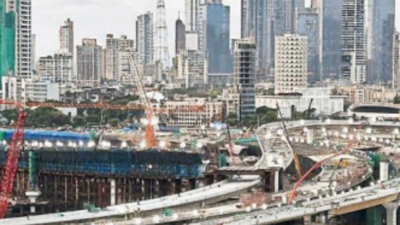- News
- City News
- mumbai News
- From sea view to no view: ‘Ad hoc devpt closing in on Mumbai cityscape’
Trending
From sea view to no view: ‘Ad hoc devpt closing in on Mumbai cityscape’

Buildings with ‘seaface’ in their names are anachronistic, say experts
For the longest time, homemaker Neha Jain enjoyed a 180-degree view of the Arabian Sea from her Prabhadevi flat.
Then, a building emerged in front of hers, chopping the view into half. A few years later, another concrete stalagmite lopped off the other half. Jain watched with despair as her ocean view went from being the equivalent of an expensive oil painting to a small water colour.
In a city that is sniffing concrete like an amphetamine, one of the many intangible losses has been the view. Before you can spell out FSI, your view might change from sea view to no view. Buildings with "ocean" or "seaface" in their names are anachronistic, as they are now confronted with a multistorey car park or flyover in place of gently lapping waves. A few years ago, people who had paid a premium for an unobstructed view in a Mahalaxmi highrise, found themselves face to face with another highrise-a pattern which is now so repetitive that some real estate brokers sheepishly prelude their sales pitch with the disclaimer: We can't guarantee the view.
Besides its aesthetic appeal, the view is one of the most underrated elements of life in Mumbai, enabling an interaction beyond the self, with the ocean or the street. Many old-time residents lament the loss of the view of street life.
The question is, do people really want to engage with the street any more? In a rapidly changing Mumbai, the streetscape has also changed and is neither as charming nor welcoming. "When we lived in homes of three and four storeys, street life was different," says brand consultant Preeti Vyas Gianetti, who has moved from a bungalow to a low-rise to a high-rise over the years. "Pavements existed, vendors would come around, and the street had a certain flavour to it. Over a period, the streets have got more and more grimy, noisy, dilapidated. Now, when I get out at Worli Naka where I live, I want to get out of there as fast as possible."
Ironically, highrise residents point out that sound travels upwards, so even if you are in a fiftieth floor penthouse, you cannot really get away from the sounds of the street, even if you have a view of the sky.
Luxury towers apart, the redevelopment of slums and chawls is equally being designed to maximise profitability at the cost of soft lifestyle factors like a nourishing view or just healthy space between buildings, say experts.
"The government cannot behave like a private developer," says civil engineer and planner Shirish Patel, who has been actively suggesting that the massive BDD chawl redevelopment in Parel take open space into consideration instead of creating the vertical Legoland that is currently being envisaged. "The inhabitants are as greedy as the government. They are going to end up with a situation that is unhealthy and unsustainable."
There is a quiet frustration with which many planners are observing the ad hoc development that has besieged the city and its aspirations to turn into some version of an international city. "We are in a post-planning phase, pandering to impatient capital," says architect Rahul Mehrotra, the chair of the urban planning and design department at Harvard University. "Economics and profit have replaced the traditional social, environmental and aesthetic elements. In this process, major urban interventions have often resulted in dramatic chaotic and unexpected visual arrangements."
His views are countered by the real estate community pandering to a perennially aspirational city. In fact, this growth spurt is nothing new in Mumbai which has unabashedly reclaimed land, thrust out open spaces, and remains in a constant jostle with itself. Many suggest that the new interventions in development and infrastructure are going to benefit the public. "Mumbai's quality of development for the income that we are at per capita is very high," says developer Abhishek Lodha. "I think that we have to remember that the hand of the market is ultimately the best balancing force -any other form of intervention leads to much higher forms of vested interests."
While the debates and discussions over development grow more polemical, in Mumbai the room with a view is gradually turning into a heritage subject. And, for now, the national bird seems to have become a crane.
Then, a building emerged in front of hers, chopping the view into half. A few years later, another concrete stalagmite lopped off the other half. Jain watched with despair as her ocean view went from being the equivalent of an expensive oil painting to a small water colour.
In a city that is sniffing concrete like an amphetamine, one of the many intangible losses has been the view. Before you can spell out FSI, your view might change from sea view to no view. Buildings with "ocean" or "seaface" in their names are anachronistic, as they are now confronted with a multistorey car park or flyover in place of gently lapping waves. A few years ago, people who had paid a premium for an unobstructed view in a Mahalaxmi highrise, found themselves face to face with another highrise-a pattern which is now so repetitive that some real estate brokers sheepishly prelude their sales pitch with the disclaimer: We can't guarantee the view.
Besides its aesthetic appeal, the view is one of the most underrated elements of life in Mumbai, enabling an interaction beyond the self, with the ocean or the street. Many old-time residents lament the loss of the view of street life.
"Redevelopment, and the speed with which it is taking place, is directly affecting a time-tested timepass: Standing at the window and looking outside, taking in the little corner of the city where one lives," says urban historian Nikhil Rao who finds the city of his childhood bafflingly unrecognisible, especially central Mumbai which now resembles a miniature Dubai randomly emerging out of chaos.
The question is, do people really want to engage with the street any more? In a rapidly changing Mumbai, the streetscape has also changed and is neither as charming nor welcoming. "When we lived in homes of three and four storeys, street life was different," says brand consultant Preeti Vyas Gianetti, who has moved from a bungalow to a low-rise to a high-rise over the years. "Pavements existed, vendors would come around, and the street had a certain flavour to it. Over a period, the streets have got more and more grimy, noisy, dilapidated. Now, when I get out at Worli Naka where I live, I want to get out of there as fast as possible."
Ironically, highrise residents point out that sound travels upwards, so even if you are in a fiftieth floor penthouse, you cannot really get away from the sounds of the street, even if you have a view of the sky.
Luxury towers apart, the redevelopment of slums and chawls is equally being designed to maximise profitability at the cost of soft lifestyle factors like a nourishing view or just healthy space between buildings, say experts.
"The government cannot behave like a private developer," says civil engineer and planner Shirish Patel, who has been actively suggesting that the massive BDD chawl redevelopment in Parel take open space into consideration instead of creating the vertical Legoland that is currently being envisaged. "The inhabitants are as greedy as the government. They are going to end up with a situation that is unhealthy and unsustainable."
There is a quiet frustration with which many planners are observing the ad hoc development that has besieged the city and its aspirations to turn into some version of an international city. "We are in a post-planning phase, pandering to impatient capital," says architect Rahul Mehrotra, the chair of the urban planning and design department at Harvard University. "Economics and profit have replaced the traditional social, environmental and aesthetic elements. In this process, major urban interventions have often resulted in dramatic chaotic and unexpected visual arrangements."
His views are countered by the real estate community pandering to a perennially aspirational city. In fact, this growth spurt is nothing new in Mumbai which has unabashedly reclaimed land, thrust out open spaces, and remains in a constant jostle with itself. Many suggest that the new interventions in development and infrastructure are going to benefit the public. "Mumbai's quality of development for the income that we are at per capita is very high," says developer Abhishek Lodha. "I think that we have to remember that the hand of the market is ultimately the best balancing force -any other form of intervention leads to much higher forms of vested interests."
While the debates and discussions over development grow more polemical, in Mumbai the room with a view is gradually turning into a heritage subject. And, for now, the national bird seems to have become a crane.
Start a Conversation
FOLLOW US ON SOCIAL MEDIA
FacebookTwitterInstagramKOO APPYOUTUBE










